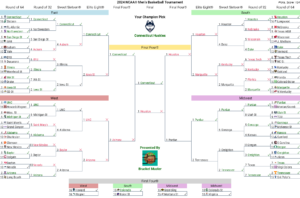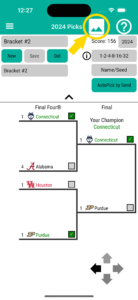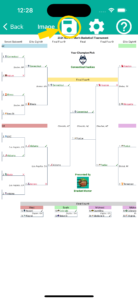Our first new feature of 2025 allows you to save entire brackets to your device for usage outside of the Bracket Master app. Create the best-looking tournament brackets anywhere!

This functionality is provided from the Years tournament pages, the Picks page, and the Simulation page. Bracket images are saved as a standard ‘.png’ file and may be viewed using your pictures gallery, shared online, printed for examination in a larger format, or perhaps submitted to a bracket pool.
Tap on the Save Image ‘panorama image’ icon at the top right of the screen to
generate a picture of the entire bracket.  When using this function from the Picks page, a bracket image will be generated showing your game selections with color-coding for correct and incorrect picks based on game results. The Years and Sim pages will show brackets displaying the score of official or simulated games, respectively. Remember to Tap the Help ‘question mark’ icon for guidance on any of Bracket Masters pages.
When using this function from the Picks page, a bracket image will be generated showing your game selections with color-coding for correct and incorrect picks based on game results. The Years and Sim pages will show brackets displaying the score of official or simulated games, respectively. Remember to Tap the Help ‘question mark’ icon for guidance on any of Bracket Masters pages.
Tap the Save ‘floppy disk’ icon to save the bracket image to your device.  The save location will default to the general user location of your device, though you can select a specific location using the save dialog. The image will be assigned a generated file name, though this may be changed using the save dialog, or from the Image Settings page (by tapping the gear icon). Use your device’s Files app to access the image after saving it. Using an Apple device, the bracket image won’t be accessible by the picture Gallery app unless you actively Share it to the pictures folder or an album using the Files app Share functions. Also use the Share function to text message or email the image. With an Android device, the bracket image will typically be automatically accessible by other apps, but if it isn’t the process is similar to that of Apple devices — use an Android file management app to Share the image with other apps or move it to another folder.
The save location will default to the general user location of your device, though you can select a specific location using the save dialog. The image will be assigned a generated file name, though this may be changed using the save dialog, or from the Image Settings page (by tapping the gear icon). Use your device’s Files app to access the image after saving it. Using an Apple device, the bracket image won’t be accessible by the picture Gallery app unless you actively Share it to the pictures folder or an album using the Files app Share functions. Also use the Share function to text message or email the image. With an Android device, the bracket image will typically be automatically accessible by other apps, but if it isn’t the process is similar to that of Apple devices — use an Android file management app to Share the image with other apps or move it to another folder.
Tap the Settings ‘gear’ icon to modify the configuration of the image generation. The Image Settings page allows you to modify the bracket title line, the file name, and the optional appearance of logos, seed numbers, and game locations. See the Image Settings help page for more detail on these options.
Print your bracket image using ‘Landscape’ orientation and the ‘Shrink to Fit’ or ‘Scale to Fit’ option in your printer settings. Note that setting the display option for seed numbers and team logos to ‘All Rounds’ will cause the generated bracket to grow in width, so for tournaments with more than 32 teams the image will need to be scaled down to properly fit on a 8.5 x 11 inch or A4 piece of paper.


 When using this function from the Picks page, a bracket image will be generated showing your game selections with color-coding for correct and incorrect picks based on game results. The Years and Sim pages will show brackets displaying the score of official or simulated games, respectively. Remember to Tap the Help ‘question mark’ icon for guidance on any of Bracket Masters pages.
When using this function from the Picks page, a bracket image will be generated showing your game selections with color-coding for correct and incorrect picks based on game results. The Years and Sim pages will show brackets displaying the score of official or simulated games, respectively. Remember to Tap the Help ‘question mark’ icon for guidance on any of Bracket Masters pages. The save location will default to the general user location of your device, though you can select a specific location using the save dialog. The image will be assigned a generated file name, though this may be changed using the save dialog, or from the Image Settings page (by tapping the gear icon). Use your device’s Files app to access the image after saving it. Using an Apple device, the bracket image won’t be accessible by the picture Gallery app unless you actively Share it to the pictures folder or an album using the Files app Share functions. Also use the Share function to text message or email the image. With an Android device, the bracket image will typically be automatically accessible by other apps, but if it isn’t the process is similar to that of Apple devices — use an Android file management app to Share the image with other apps or move it to another folder.
The save location will default to the general user location of your device, though you can select a specific location using the save dialog. The image will be assigned a generated file name, though this may be changed using the save dialog, or from the Image Settings page (by tapping the gear icon). Use your device’s Files app to access the image after saving it. Using an Apple device, the bracket image won’t be accessible by the picture Gallery app unless you actively Share it to the pictures folder or an album using the Files app Share functions. Also use the Share function to text message or email the image. With an Android device, the bracket image will typically be automatically accessible by other apps, but if it isn’t the process is similar to that of Apple devices — use an Android file management app to Share the image with other apps or move it to another folder.